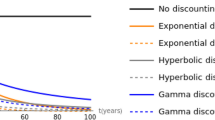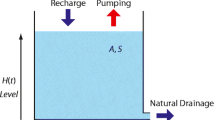Abstract
This article analyzes the sustainability of market-based instruments such as tradable permits for the management of a renewable aquifer used for irrigated agriculture. In our dynamic hydro-economic model, a water agency aims at satisfying a food security constraint within a tradable permit scheme in the presence of myopic heterogeneous agents. We identify analytically the viability kernel that defines the states of the resource yielding inter-temporal feasible paths able to satisfy the set of constraints over time and the associated set of viable quota policies. We then illustrate the theoretical results of the paper with numerical simulations based on the Western La Mancha aquifer.




Similar content being viewed by others
Notes
The model could be extended by allowing farmers to lease part of their water rights to other users and to reduce their acreage temporarily through crop rotation or fallowing. A major improvement could be a joint analysis of land and water markets. When water pumping rights are attached to land ownership, the land price will reflect the value of the rent attached to the water quota in the event of land transactions.
See Appendix.
Simple manipulations give the irrigation water demand function of Gisser and Sanchez (1980) \(W=g-k p_w\). Assuming \(m(t)=0\), we obtain \(g=\overline{W}, k=\beta /p_y\) and \(p_w\) the price of water. This equivalence will be used to calibrate the model for numerical simulations.
The authors (p.1123) derived a similar condition \(c_0 \ge g/k\) that eliminates the possibility of a corner solution for which \(H \le 0\).
The proof is given in the Appendix.
See Appendix.
References
Aubin J-P (1990) A survey of viability theory. SIAM J Control Optim 28(4):749–788
Ballestero E, Alarcon S, Garcia-Bernabeu A (2002) Etablishing politically feasible water markets: a multi-criteria approach. J Environ Manag 65:411–429
Béné C, Doyen L, Gabay D (2001) A viability analysis for a bio-economic model. Ecol Econ 36:385–396
Booker J, Howitt R, Michelsen A, Young R (2012) Economics and the modeling of water resources and policies. Nat Resour Model 25(1):168–218
Branch T (2008) How do individual transferable quotas affect marine ecosystems? Fish Fish 9:1–19
Burness SH, Brill TC (2001) The role for policy in common pool groundwater use. Resour Energy Econ 23:19–40
Clarke FH, Ledayev YUS, Stern RJ, Wolenski PR (1995) Qualitative properties of trajectories of control systems: a survey. J Dyn Control Syst 1:1–48
Chu C (2009) Thirty years later: the global growth of ITQs and their influence on stock status in marine fisheries. Fish Fish 10(2):217–230
Doyen L, De Lara M (2010) Stochastic viability and dynamic programming. Syst Control Lett 59(10):629–634
Doyen L, Pereau J-C (2012) Sustainable coalitions in the commons. Math Soc Sci 63(1):57–64
de Frutos Cachorro J, Erdlenbruch K, Tidball M (2014) Optimal adaptation strategies to face shocks on groundwater resources. J Econ Dyn Control 40:134–153
de Frutos Cachorro J, Erdlenbruch K, Tidball M (2016) A dynamic model of irrigation and land-use choice: application to the Beauce aquifer in France. European Review of Agricultural Economics. doi:10.1093/erae/jbw005
Esteban E, Albiac J (2011) Groundwater and ecosystems damages: questioning the Gisser–Sanchez effect. Ecol Econ 70:2062–2069
Esteban E, Albiac J (2012) The problem of sustainable groundwater management: the case of La Mancha aquifers Spain. Hydrogeol J 20:851–863
Esteban E, Dinar A (2016) The role of groundwater-dependent ecosystems in groundwater management. Nat Resour Model 29(1):98–129
FAO (2014) Building a common vision for sustainable food and agriculture: principles and approaches. Food and Agriculture Organization of the United Nations, Rome, 56 pp
Figureau A-G, Montginoul M, Rinaudo J-D (2014) Policy instruments for decentralized management of agricultural groundwater abstraction: a participatory evaluation. Ecol Econ 119:147–157
Gisser M, Sanchez DA (1980) Competition versus optimal control in ground water pumping. Water Resour Res 31:638–642
Knapp K, Weinberg M, Howitt R, Posnikoff J (2003) Water transfers, agriculture and qroundwater management: a dynamic economic analysis. J Environ Manag 67:291–301
Koundouri P (2004) Current issues in the economics of groundwater resource management. J Econ Surv 18(5):703–740
Latinopoulos D, Sartzetakis ES (2015) Using tradable water permits in irrigated agriculture. Environ Resour Econ 60(3):349–370
Madani K, Dinar A (2013) Exogenous regulatory institutions for sustainable common pool resource management: application to groundwater. Water Resour Econ 2–3:57–76
Martinet V, Thébaud O, Doyen L (2007) Defining viable recovery paths toward sustainable fisheries. Ecol Econ 64(2):411–422
Montginoul M, Rinaudo J-D, Brozovic N, Donoso G (2016) Controlling groundwater exploitation through economic instruments: current pratcices, challenges and innovative approaches. In: Jakeman AJ (ed) Integrated groundwater management. Springer, Berlin, pp 551–581. doi:10.1007/978-3-319-23576-9 chapter 22
Pereau J-C, Doyen L, Little L, Thébaud O (2012) The triple bottom line: meeting ecological, economic and social goals with individual transferable quotas. J Environ Econ Manag 63:419–434
Provencher B (1993) A private property rights regime to replenish a groundwater aquifer. Land Econ 69(4):335–340
Regnier E, De Lara M (2015) Robust viable analysis of a harvested ecosystem model. Environ Model Assess 20(6):687–698
Roumasset J, Wada C (2012) The economics of grounwater, WP 2012-4, UHERO-University of Hawai
Rubio SJ, Casino B (2001) Competitive versus efficient extraction of a common property resource: the groundwater case. J Econ Dyn Control 25(8):1117–1137
Tomini A (2014) Is the Gisser and Sanchez model too simple to discuss the economic relevance of groundwater management? Water Resour Econ 6:18–29
Wada Y, van Beek LPH, van Kempen CM, Reckman JWTM, Vasak S, Bierkens MFP (2010) Global depletion of groundwater resources. Geophys Res Lett 37:L20402
Wheeler SA, Schoengold K, Bjornlund H (2016) Lessons to be learned from groundwater trading in Australia and the United States. In: Jakeman AJ (ed) Integrated groundwater management. Springer, Berlin, pp 493–517. doi:10.1007/978-3-319-23576-9 chapter 20
WWAP (United Nations World Water Assessment Programme) (2015) Water for a Sustainable World. UNESCO, Paris
Acknowledgements
This study has been carried out with financial support from the French National Research Agency (ANR) in the frame of the Investments for the future Program, within the Cluster of Excellence COTE (ANR-10-LABX-45). We thank the two referees and the co-editor for their suggestions, always stimulating.
Author information
Authors and Affiliations
Corresponding author
Appendix
Appendix
1.1 Optimality Conditions
The Lagrangian corresponding to the problem (4) with \(w_{i} \ge 0\) and \(q_{i} \ge 0\) is
The Kuhn-Tucker conditions are
If \(\lambda _{i}=0\), the constraint does not bind then \(w_{i}^{*}\) is solution of \(\partial \pi _{i}\left( H,w_{i}\right) /\partial w_{i}=0\) and \(q_{i}=0\). Otherwise \(\lambda _{i}>0\) implies a positive quota price \(m>0\). It shows that the constraint binds \( q_{i}=w_{i}\) and \(\frac{\partial \pi _{i}\left( H,q_{i}\right) }{\partial q_{i}}=m\) which gives Eq. (5).
1.2 Proof of the Viability Kernel
Proof
Consider the dynamics
with \(Q_{R}=\frac{R}{1-\mu }\).
We first show that \(Q_{FS}\le Q_{R}\) implies \(Viab=\left[ H_{\lim }, S_L \right] \).
Assume that \(H_0 \ge H_{\lim }\), choose \(Q(t)=Q_{FS}\) then
Hence \(\left[ H_{\lim }, S_L \right] \) is viable and \(Viab=\left[ H_{\lim }, S_L \right] \).
Now if \(Q_{FS}>Q_R\), we show by forward induction that \(\forall H_0 \ge H_{\lim }\)
Hence \(\exists t^{*}\) such that \(H(t^{*})< H_{\lim }\), it implies that \( Viab=\emptyset \).
1.3 Dynamic Constraint \(Q_D\)
The constraint on the state variable \(H_{\lim } \le H(t+1)\) implies
By denoting \(Q_D= Q_{R}-\frac{AS}{(1-\mu )}H_{\lim } +\frac{AS}{(1-\mu )}H(t)\), it gives \(Q(t)\le Q_D(H(t))\). We look at the conditions depending on the sign of \(Q_M-Q_D\) under which this dynamic constraint is binding and reduces the viability kernel. By definition, \(Q_D(H_{\lim })=Q_R\) and since Q is bounded by \(Q_R\), it implies that for \(H=H_{\lim }\)
It yields
The expression of \(Q_M-Q_D\) is given by
Using the two previous expressions gives
When \(H>H_{\lim }\) the condition ensuring \(Q_M-Q_D>0\) is
and corresponds to Eq. (29) in the text.
Rights and permissions
About this article
Cite this article
Pereau, JC., Mouysset, L. & Doyen, L. Groundwater Management in a Food Security Context. Environ Resource Econ 71, 319–336 (2018). https://doi.org/10.1007/s10640-017-0154-3
Accepted:
Published:
Issue Date:
DOI: https://doi.org/10.1007/s10640-017-0154-3
Keywords
- Groundwater
- Agriculture
- Irrigation
- Food security
- Individual permits
- Sustainability
- Dynamic model
- Viability kernel




